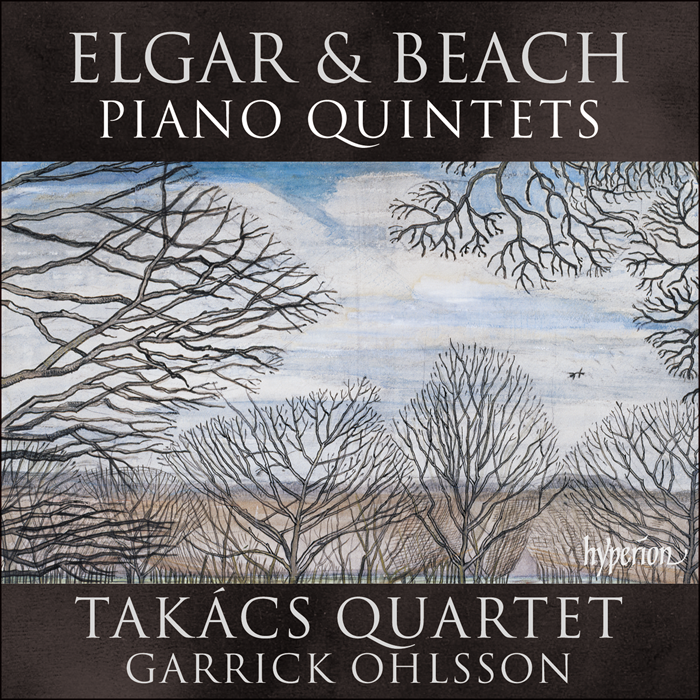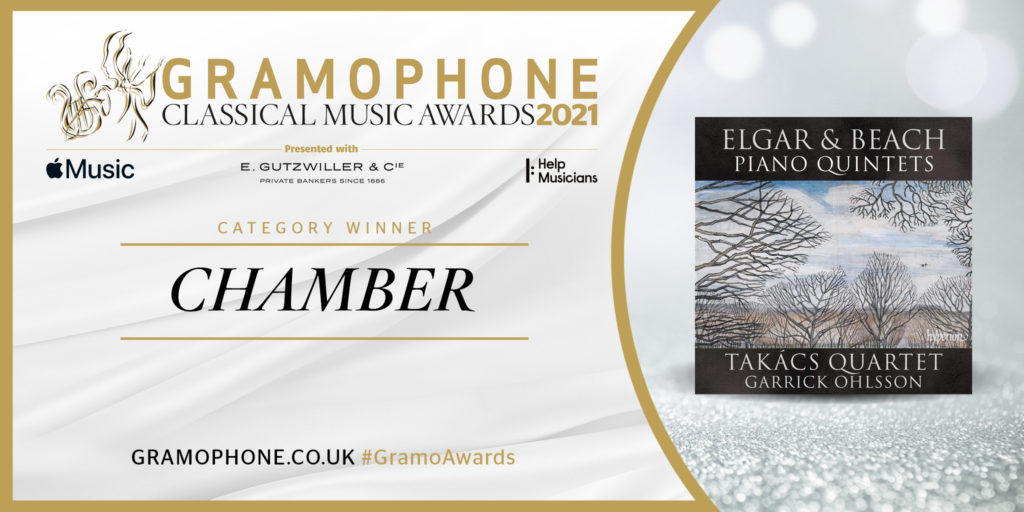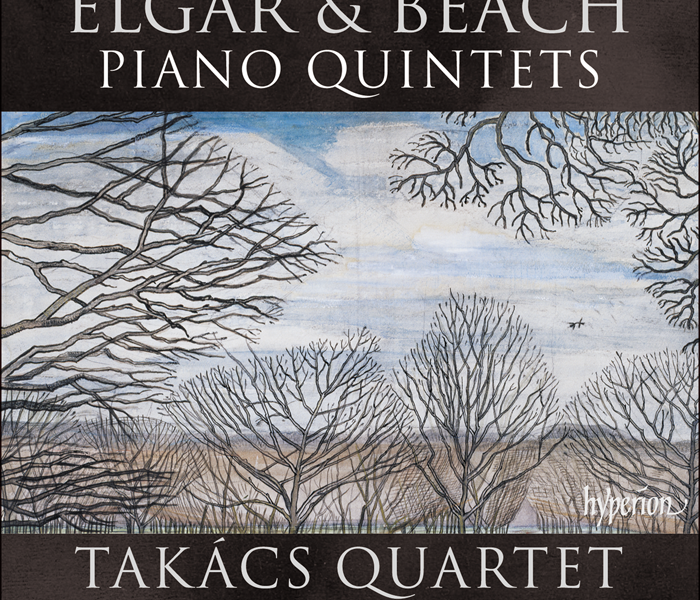Elgar & Beach: Piano Quintets

From Hyperion:
The piano quintet is a form that came of age in the second half of the nineteenth century. After Schumann’s pioneering work of 1842—the piece that established the combination of piano and string quartet in the chamber music repertoire—others soon followed, notably Brahms (completed in 1864), Franck (1879) and Dvořák (1887, his second piano quintet; an earlier work was written in 1872). Others included two each by Gernsheim, Goldmark and Widor, and single works by Berwald, Herzogenberg, Saint-Saëns, Sinding and Stanford. Younger composers to tackle the form included Coleridge-Taylor (1893), Dohnányi (1895 and 1914), Fauré (1905 and 1921), Novák (1896), Pfitzner (1908), Reger (1898 and 1902), Respighi (1902), Suk (1893), Turina (1907), Wolf-Ferrari (1900) and the young Bartók (1904).
Both composers on the present recording were at the height of their musical powers when they turned to the piano quintet, and like Schumann, Brahms and Franck (among others), each composed just one. The autograph manuscript of the Piano Quintet in F sharp minor, Op 67, by Amy Beach is dated 14 December 1907, a decade after she had written two very successful large-scale works for orchestra: the Gaelic Symphony (1894–96) and the Piano Concerto (1899). The opening adagio is hushed and mysterious, with long high string notes (an impressionistic foreshadowing of the music that is to follow) punctuated by harmonically ambiguous piano figuration. After this introduction, the main sonata-form allegro moderato introduces a theme that is an explicit reference to Brahms’s piano quintet, specifically the second theme in the fourth movement (starting at bar 94), from which Beach’s melody—initially heard on the first violin—is derived. Variants of this theme, with its distinctive falling phrases, are to be heard in all three movements of Beach’s quintet: a work that is truly imbued with the spirit of Brahms without ever sounding derivative. The second theme is more lyrical, first heard on the piano (decorated with gently floated octaves) before being taken up by the strings. Both themes are treated to some highly dramatic development and a recapitulation in which the second theme, in particular, is delicately varied, before the music subsides into a quiet coda.
The slow movement, in D flat major, opens with muted strings introducing an idea in which elements of the ‘Brahms’ theme have been transformed into a dream-like allusion. A more chromatic and turbulent central section is followed by a return to the opening material, reaching a climax of great intensity before coming to a state of tranquil serenity.
The finale begins in a state of restless agitation, the piano theme decorated by string figuration before a descending piano scale heralds the arrival of the main theme: a capricious melody but one that never seems fully settled, and with serpentine contours that reveal yet another transformation of the ‘Brahms’ theme, eventually heard in the strings. After this welter of musical activity, the tempo slows for a broader central section with an eloquent new theme, introduced by the viola over piano chords. Over shuddering tremolos the opening idea is hinted at before returning in a wraith-like fugal passage, culminating in a dramatic flourish that leads to a reprise of the adagio from the very opening of the quintet. After an episode of quiet lyrical intensity, Beach unleashes a coda in which the ‘Brahms’ theme appears again, this time in octaves in the strings (just as it does in the coda of Brahms’s quintet), before the two triumphant chords of F sharp major bring the work to a close.
The first performance was given by Beach herself, with the Hoffmann String Quartet, at Potter Hall, Boston, on 27 February 1908. Beach’s biographer Adrienne Fried Block has noted that ‘the audience was unusually large, drawn by interest in Beach’s later work’, and that the Boston critics, ‘in an instance of unanimity, greeted the work as an important contribution to the literature’. During her lifetime Beach performed the work on numerous occasions—including a series of performances on tour with the Kneisel Quartet in 1916/7—and it was published by the Boston firm of Arthur P Schmidt in 1909. A century later, it has come to be regarded as an impressive and individual successor to its great nineteenth-century models, particularly, of course, the Brahms piano quintet, to which it can be considered a highly original and distinctive homage.
After a couple of years during which Edward Elgar’s health—mental and physical—had been precarious, he finally regained creative inspiration in 1918. The Piano Quintet in A minor was one of a trilogy of chamber works (the others being the Violin Sonata and String Quartet) conceived—along with the Cello Concerto—in the rural seclusion of Brinkwells, a cottage in West Sussex near Fittleworth, which the composer rented from the artist Rex Vicat Cole. Alice, Lady Elgar, was delighted by her husband’s new-found motivation to compose, and by the sound of his latest pieces, noting in her diary: ‘E. writing wonderful new music, different from anything else of his … wood magic, so elusive and delicate.’ Elgar started work on the Piano Quintet in September 1918, as soon as he had completed the Violin Sonata. He worked on it intermittently while also finishing the String Quartet throughout the autumn. The finale of the quartet was dated 23 December 1918, and Elgar continued to revise and refine the Piano Quintet until April 1919.
The piano part opens with a theme that seems to be a quotation from the first four notes of the plainchant Salve regina (solemn tone)—the notes A, G, A, D—here marked to be played quietly and ‘serioso’. As well as appearing again in the first movement (including a haunting recollection in the coda), this motif, simple and austere, has an important part in the musical argument of the whole quintet: it also returns in the quiet central section of the third movement. Whether it was a deliberate allusion to the famous Catholic antiphon is unclear, though as a Roman Catholic, Elgar would have known this chant well. At the start of the quintet, this theme is set against nervous, uneasy string phrases. Lady Elgar wrote about this passage in her diary:
Wonderful weird beginning—same atmosphere as Owls [the choral song, Op 53 No 4], evidently reminiscence of sinister trees & impression of Flexham Park … sad ‘dispossessed’ trees & their dance & unstilled regret for their evil fate—or rather curse.
Evidence from the published score suggests that the ‘sinister trees’ Elgar had in mind were in nearby Bedham Copse: the end of the first movement is dated ‘Bedham, 1918’. A tangle of local legends (including stories about an ancient community of monks who may or may not have been Spanish) gets us no closer to understanding Elgar’s expressive intentions here. As Michael Kennedy suggests, Elgar’s friend Algernon Blackwood—a fine teller of spooky tales—may well have fired his imagination during a walk they took together in the woods in Bedham on 18 July 1918. Later, Alice Elgar suggested a different literary association for the quintet: Edward Bulwer-Lytton’s supernatural novel, A Strange Story (1862). Ernest Newman, to whom Elgar dedicated the quintet, wrote in 1931 about a ‘quasi-programme that lies at the base of the work’, but exactly what this was remains a typically Elgarian mystery. Despite a profusion of contrasting thematic material—including a second subject that was characterized by Elgar’s friend W H Reed as ‘Spanish, Moorish, or possibly Oriental’—this broadly conceived sonata-form movement has an undertone of restless anxiety. As Reed put it in his article for Cobbett’s Cyclopedic Survey of Chamber Music, published in 1929: ‘With alternations and elaborations of these moods, this remarkable movement proceeds through the development and recapitulation sections, until it ends in rather a gloomy manner, leaving the listener with an uncanny feeling of awe.’
The slow movement, in E major, opens with strings alone, the hushed main theme on the viola. With the entry of the piano a few bars later, the theme is restated in the first violin and the music then seems to evolve in a natural, highly expressive flow of ideas, described in Reed’s commentary as encapsulating ‘all the higher ideas of which humanity is capable. It expresses them so truly and sincerely, and goes so much farther into the hidden meaning of things than can any mere words, that it seems to be a message from another world.’ The finale is in A major, but it begins with an ambiguous, questioning idea which punctuates much of what follows, before the first main idea—a swaying triple-time theme marked ‘con dignità’—is subsequently developed and extended until a climactic restatement marked ‘nobilmente’. The second theme is a syncopated, chordal idea introduced by the piano before being taken up by the whole ensemble and leading to a passage in which the music is increasingly animated, and with a rhythmic character that has distinct echoes of Brahms. A more tranquil central section follows in which the opening Salve regina theme makes a return, this time transformed by a warm, steady chordal accompaniment, very different from the agitated string motif against which it was first heard at the start of the quintet. Both main ideas are used to drive this finale to its close, with the syncopated second theme presented ‘grandioso’ in a fine peroration before a final explosion of energy brings this work to a powerful close.
Elgar arranged a private performance of the first movement at his London home (Severn House in Hampstead) on 7 January 1919, and others followed, including a play-through of the whole work on 7 March. The composer had invited Ernest Newman to this performance, to hear the new work that was dedicated to him, but Newman was unable to be there. But George Bernard Shaw was, and he wrote to Elgar the next day: ‘The Quintet knocked me over at once. I said to myself, with the old critic’s habit of making phrases for publication, that this was the finest thing of its kind since [Beethoven’s] Coriolan. I don’t know why I associated the two; but I did: there was the same quality—the same vein. Of course, you went your own way presently.’ Shaw also praised Elgar’s own playing of the piano part which ‘didn’t sound like a piano or anything else in the world, but quite beautiful … a touch which is peculiar to yourself, and which struck me the first time I ever heard you larking about with a piano’. The first public performance was given six weeks later, at the Wigmore Hall on 21 May 1919. On that occasion it was played by the pianist William Murdoch with a quartet comprising Albert Sammons and W H Reed (violins), Raymond Jeremy (viola) and Felix Salmond (cello) in a concert that also included the premiere of the String Quartet, and the second public performance of the Violin Sonata (played by Sammons and Murdoch)—an early opportunity for the London public to hear all of Elgar’s chamber music inspired by his time at Brinkwells in 1918.
Nigel Simeone © 2020
Cover artwork: The Cherry Orchard (1917) by Paul Nash (1889-1946)
Photo © Tate, London
Critical acclaim:

“Are we getting there? Are we finally building a more inclusive culture in classical music?”
Those were the questions I asked 12 months ago in our end-of-year roundup, noting a flurry of worthwhile recordings of works by women composers. Ask the same question again now, and the answer would have to be a stronger — if still preliminary and heavily caveated — yes.
On record, the momentum continues… The Takacs Quartet has followed its superb account of Amy Beach’s Piano Quintet with an equally convincing version of Fanny Mendelssohn’s String Quartet (Hyperion).”
Best Classical Music of 2021 – The New York Times
“The Takács Quartet and pianist Garrick Ohlsson, without excess or hysterics, plumb every emotional possibility.”
“It took more than a century, but Amy Beach’s Piano Quintet has finally got the recording it deserves, courtesy of Garrick Ohlsson and the Tákacs Quartet. Written in 1909, Beach’s Quintet is a glorious piece, it’s three movements marked by a mix of rhapsodic lyricism, virtuosity, and lush, late-Romantic chromatic harmony.
The present recording draws out those qualities mightily. Ohlsson’s account of the demanding keyboard writing (Beach was, throughout her life, an acclaimed pianist) is never less than breathtaking, beautifully voiced and brimming with color. He and the Quartet weave in and out of their foreground/background roles in the piece with the utmost naturalness, ably drawing out the subtleties of Beach’s highly motivic writing in the process (the ravishing second movement is a particular highlight).
A similar brilliance of execution marks their reading of Sir Edward Elgar’s epic 1919 Piano Quintet, which rounds out the album. This is a smart pairing: structurally and technically, both pieces have more than a little bit in common, including an elegiac, serious tone even at their most upbeat moments.
Here, Ohlsson and the Quartet deliver taut, cleanly balanced readings of the outer movements (the contrasts between the first’s lean, inward-focused moments and brawny, extroverted ones are conspicuously gripping), while the slow second is radiant: by the end, it’s almost as though the music is glowing from within.
In all, then, a terrific release, wholly satisfying, and timely as ever. To boot: one might hope that this can help nudge the Beach Quintet to its proper place as a cornerstone of the chamber music repertoire.”
“This excellent release celebrates two glorious pieces for piano quintet with performances of unabashed élan. The Takács Quartet are renowned for the warmth and drama of their playing and could not be a better fit for such full-blooded works, while Ohlsson, a noted Chopin exponent, proves a similarly fine match in this generous, lyrical interpretation.
Elgar’s Piano Quintet is one of the masterpieces of the genre, by turns mysterious, affecting and joyful. Ohlsson and the Takács Quartet are vividly alert to the work’s sense of story, particularly to the hints of the supernatural in the ‘wonderful weird beginning’, as Lady Elgar described the quintet’s very opening. This is a performance every bit as imaginative and expressive as Elgar’s remarkable score, rich in contrast and daring but never overblown and always precise. With excellent recording quality throughout, this is in every respect an outstanding disc.”
- Release Date:
- June 12, 2020
- Number of Discs:
- 1
- Label:
- Hyperion Records Limited
- Copyright:
- (C) 2020 Hyperion Records Limited
- Total Length:
- 63:35
